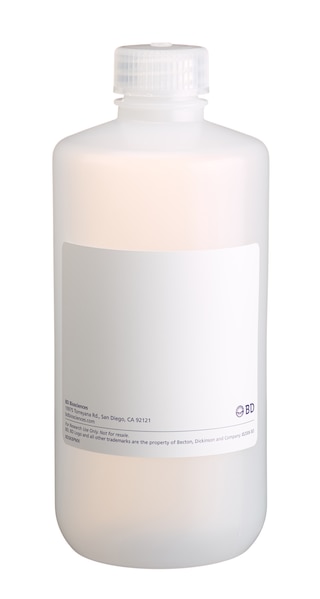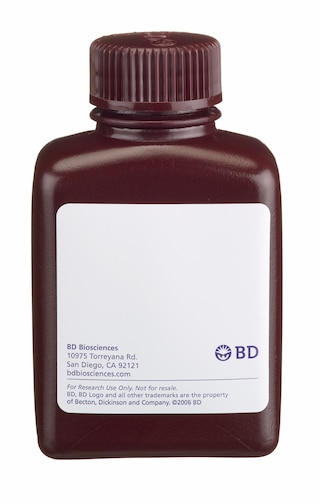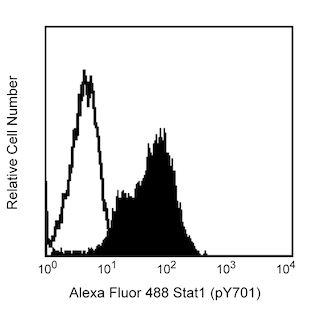Old Browser
This page has been recently translated and is available in French now.
Looks like you're visiting us from {countryName}.
Would you like to stay on the current country site or be switched to your country?




Analysis of IGF-1 Receptor (pY1131) in transformed human epithelial cells. Serum-starved 293 fetal kidney cells were either stimulated at 37°C for 2 minutes with 100 nM IGF-I (shaded histogram) or unstimulated (open histogram). The cells were fixed with pre-warmed BD Cytofix™ buffer (Cat. No. 554655) for 10 minutes at 37°C, then permeabilized (BD Phosflow™ Perm Buffer III, Cat. No. 558050) on ice for at least 30 minutes, and then stained with Alexa Fluor® 647 Mouse anti-IGF-1 Receptor (CD221) (pY1131, Cat. No. 558588). Flow cytometry was performed on a BD FACSCalibur™ flow cytometry system.


BD™ Phosflow Alexa Fluor® 647 Mouse anti-IGF-1 Receptor (CD221) (pY1131)

Regulatory Status Legend
Any use of products other than the permitted use without the express written authorization of Becton, Dickinson and Company is strictly prohibited.
Preparation And Storage
Product Notices
- This reagent has been pre-diluted for use at the recommended Volume per Test. We typically use 1 × 10^6 cells in a 100-µl experimental sample (a test).
- Source of all serum proteins is from USDA inspected abattoirs located in the United States.
- Caution: Sodium azide yields highly toxic hydrazoic acid under acidic conditions. Dilute azide compounds in running water before discarding to avoid accumulation of potentially explosive deposits in plumbing.
- Alexa Fluor® 647 fluorochrome emission is collected at the same instrument settings as for allophycocyanin (APC).
- Alexa Fluor® is a registered trademark of Molecular Probes, Inc., Eugene, OR.
- The Alexa Fluor®, Pacific Blue™, and Cascade Blue® dye antibody conjugates in this product are sold under license from Molecular Probes, Inc. for research use only, excluding use in combination with microarrays, or as analyte specific reagents. The Alexa Fluor® dyes (except for Alexa Fluor® 430), Pacific Blue™ dye, and Cascade Blue® dye are covered by pending and issued patents.
- For fluorochrome spectra and suitable instrument settings, please refer to our Multicolor Flow Cytometry web page at www.bdbiosciences.com/colors.
- Please refer to www.bdbiosciences.com/us/s/resources for technical protocols.
Companion Products




Insulin-like growth factor-1 (IGF-1) receptor, or CD221, is a receptor tyrosine kinase that has high affinity for IGF-1 and low affinity for insulin and IGF-2. Each transmembrane protein complex is formed from a pair of 1367 amino-acid precursor proteins. After the 30 amino-acid signal sequences are removed, the paired polypeptides are cleaved to derive an α and β chain from each. The two extracellular α chains form the ligand-binding domain, while the transmembrane-and-intracellular β chains carry the kinase activity. Upon stimulation by its ligand, IGF-1 receptor autophosphorylates multiple tyrosine sites in its β chains and phosphorylates other signaling mediators that regulate cell growth, development, and neoplastic transformation.
The K74-218 monoclonal antibody recognizes the phosphorylated tyrosine 1131 (pY1131) in the activation loop of IGF-1 receptor's kinase domain. The orthologous phosphorylation sites in mouse and rat IGF-1 receptor are Y1133 and Y1132, respectively.
Development References (4)
-
Brodt P, Fallavollita L, Khatib A-M, Samani AA, Zhang, D. Cooperative regulation of the invasive and metastatic phenotypes by different domains of the type I insulin-like growth factor receptor β subunit. J Biol Chem. 2001; 276(36):33608-33615. (Biology). View Reference
-
Dufresne AM, Smith RJ. The adapter protein Grb10 is an endogenous negative regulator of insulin-like growth factor signaling. Endocrinology. 2005. (Biology).
-
Mitsiades CS, Mitsiades NS, McMullan CJ, et al. Inhibition of the insulin-like growth factor receptor-1 tyrosine kinase activity as a therapeutic strategy for multiple myeloma, other hematologic malignancies, and solid tumors. Cancer Cell. 2004; 5:221-230. (Biology). View Reference
-
Ullrich A, Gray A, Tam AW, et al. Insulin-like growth factor I receptor primary structure: comparison with insulin receptor suggests structural determinants that define functional specificity. EMBO J. 1986; 5(10):2503-2512. (Biology).
Please refer to Support Documents for Quality Certificates
Global - Refer to manufacturer's instructions for use and related User Manuals and Technical data sheets before using this products as described
Comparisons, where applicable, are made against older BD Technology, manual methods or are general performance claims. Comparisons are not made against non-BD technologies, unless otherwise noted.
For Research Use Only. Not for use in diagnostic or therapeutic procedures.
Report a Site Issue
This form is intended to help us improve our website experience. For other support, please visit our Contact Us page.